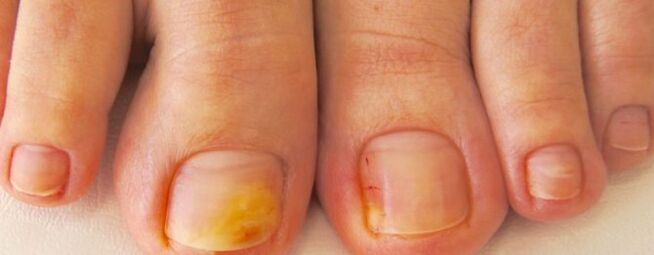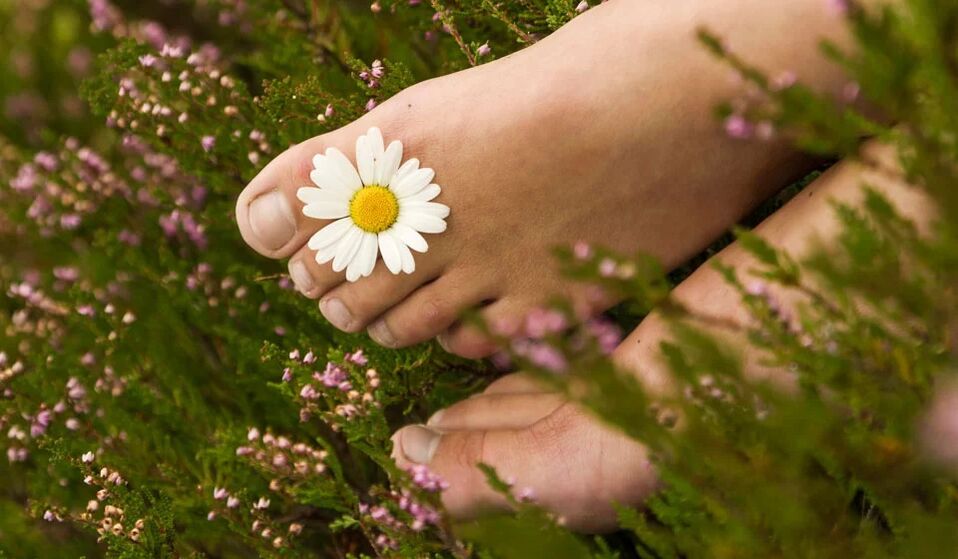In medicine, nail fungus is officially called onychomycosis.It is a disease of a fungal nature that affects the plates of the nails on the fingers or toes.According to the WHO, this is a very common disease.It is found in about 27% of people, and the pathology is diagnosed 2 times more often than the hands.The problem with the nail sponge is very delicate as the unpleasant type of affected plates causes the patient to feel discomfort and hide them from others.
Symptoms and signs of nail fungus
Onychomycosis is very easy to recognize as its nail signs cannot be ignored.At first, nail signs turn dumb and rough, losing their shiny shine.Then, instead of pink, the nail acquires dirty yellow, whitish or gray.Next, other characteristic symptoms of the fungus appear:
- Increase in the thickness of the plate;
- defects in the form of stripes, turns, irregularities and waves;
- Relaxation and squeezing of the plate;
- Unpleasant nail odor.

As a result, the nail is completely destroyed and even exfoliated, exposing the bed under the nail.The skin to the plates turns red and causes severe itching.
Reasons
The main reason for the development of fungal infections is to enter the body or inside the human body.As a rule, these are Mikrosporum, Metridium and Epidermofiton.These are the fungi cause onychomycosis especially often.
When it enters the body, such mushrooms are located on keratinized skin derivatives, ie.Nails and hair.This is due to the nutrition of parasites for which they use fibrillary protein keratin, which is available in nails and hair.
Ways of infection
The risk of getting infection with a fungus in public places with high humidity is particularly high.These are saunas, pools, gyms, public baths and more.The most common ways of infection:
- Direct contact with an infected person.Here the sponge falls from its habitat on healthy areas, thus causing infection;
- Household road.In this case, the infection occurs when using the patient's personal things: shoes, personal hygiene elements, etc.
Risk factors
The incidence of onychomycosis increases by 60 years.At present, the likelihood of developing such an infection is 60%, which is explained by a delay in metabolism, especially in distal (distant) areas of the body, which are only toes and toes.
Other risk factors for the development of nail fungus include:
- Diabetes sugar;
- varicose veins;
- nail injuries and adjacent tissues;
- HIV and other conditions of immunodeficiency;
- Long -term administration of antibiotics;
- weakened immunity;
- Vascular and skin diseases, dermatitis, diaper rash;
- impaired blood supply to the limbs;
- Insufficient hygiene.
Complications
With an uncomplicated course, the disease causes symptoms traditional for fungi, causing a person only severe discomfort.But without treatment, onychomycosis can cause complications.Most often, they occur in the addition of bacterial infection.
Sometimes onychomycosis is very acute with the appearance of bubbles, ulcers and crying areas on the skin to the nail.In severe cases, the disease takes a generalized form.This means that the nail fungus is applied to internal organs and systems and then the patient will need emergency hospitalization.
When to consult a doctor
Many who have encountered onychomycosis know that the disease develops slowly and is treated with incredible work.Therefore, it is very important to consult a doctor when the first signs of the disease appear.The treatment of onychomycosis of the nails is engaged with a dermatologist.The specialist will provide competent assistance and lead you to a complete recovery.
Preparing to visit a doctor
Before taking a dermatologist, it is important not to process the affected areas of the nails, ie.Do not use medicines, including iodine and green.It is also necessary to exclude the use of creams and ointments from the fungus.It is worth taking all the early tests, including for other diseases.The affected nails cannot be cut for 3-4 days before consultation.
Diagnosis of nail fungus
First, the patient is directed to a microscopy, allowing you to identify the presence of the pathogen.In the future, it is necessary to determine its variety in order to choose the right treatment of the fungus of the toenails.The most modern and common methods for diagnosing onychomycosis are practiced:
- Bacteriological sowing.For this, a biological sample of the affected tissues in an artificial nutrient environment is placed, where the pathogen is grown to determine its type;
- The method of polymerase chain reaction (PCR) to detect the pathogen DNA in the sample of the affected tissues.
Treatment
In the early stages of the disease, local therapy is generally prescribed, which consists in the use of creams and ointments with antifungal effects.
Antiseptic solutions are also used as nail fungus products.In addition to effective nail onychomycosis tools, antihistamines and desensitizing drugs are prescribed that relieve swelling, inflammation and sensitivity.
If the nail is completely influenced by the fungus and the treatment with drugs does not produce positive results, then the plaque is undergoing surgical removal.In addition, with a common form of onychomycosis, antifungal drugs in the form of tablets that have a systemic effect on the body are prescribed inside.
Home treatment products
You should consult a doctor before using home treatment.At its resolution you can use the following recipes:
- iodine.Before using your feet, it is necessary to soak, rinse with the home soap, and then remove the affected areas of the nails.Then treat the nails and skin between the fingers with iodine, withstand them in a bath with a solution of baking soda for 20-30 minutes and dry thoroughly;
- Vinegar.For 3 liters of water, take 1 tablespoon of apple cider vinegar and add some potassium permanganate.Keep your feet in the bath for 20-30 minutes, then dry thoroughly;
- Hydrogen peroxide.By reducing the legs, remove the affected areas of the nails.Put on them cotton wheels moistened with hydrogen peroxide, wrap with a bandage and leave for half an hour.
Myths and dangerous misconceptions in the treatment of nail fungus
One of the most important and dangerous myths is that nail fungus is not considered a serious illness.In fact, onychomycosis, progressive, can have serious consequences to deformation and complete nail rejection from the nails.
In addition, the infected person poses a danger to loved ones every day because, because they are there, they also risk getting sick.That is why it is important to know how to cure nail fungus on time.
Prevention
In order to prevent the development of onychomycosis, it is necessary to exclude the negative effect on the body of risk factors:

- Treatment of systemic diseases over time;
- Do not wear one's shoes;
- in the pool and sauna to walk in slate;
- Replace socks daily and follow the rules of personal hygiene;
- Do not wear wet shoes - dry it well;
- Turn off direct contact with potential fungi.
















